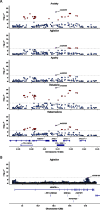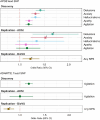This is a preprint.
GWAS links APOE to neuropsychiatric symptoms in mild cognitive impairment and dementia
- PMID: 39974048
- PMCID: PMC11838693
- DOI: 10.1101/2025.01.31.25321498
GWAS links APOE to neuropsychiatric symptoms in mild cognitive impairment and dementia
Update in
-
GWAS links APOE to neuropsychiatric symptoms in mild cognitive impairment and dementia.Alzheimers Dement. 2025 Jun;21(6):e70329. doi: 10.1002/alz.70329. Alzheimers Dement. 2025. PMID: 40495575 Free PMC article.
Abstract
Introduction: Neuropsychiatric symptoms in dementia (NPS) collectively refer to behavioral and psychological symptoms affecting individuals with mild cognitive impairment (MCI) or Alzheimer's disease or related dementia (ADRD). NPS are among the most troubling aspects of living with dementia and their treatments have limited efficacy. We aim to investigate genetic variants contributing to NPS to identify new therapeutic targets.
Methods: We performed a genome-wide association study (GWAS) for nine NPS domains measured by the NPI-Q in 12,800 participants of European ancestry with MCI or ADRD recruited by Alzheimer's disease research centers across the U.S.
Results: We found genome-wide significant signals for agitation, anxiety, apathy, delusions, and hallucinations in the APOE locus that were driven by the APOE ε4 allele. We replicated these findings in two independent datasets. Mediation analyses revealed that MCI/ADRD severity only partially mediated the GWAS signals, except for apathy.
Discussion: These findings suggest the APOE ε4 allele influences NPS independently of and beyond its effect on ADRD.
Conflict of interest statement
9 Declaration of Interests None.
Figures




References
-
- Clement A., Wiborg O. & Asuni A. A. Steps Towards Developing Effective Treatments for Neuropsychiatric Disturbances in Alzheimer’s Disease: Insights From Preclinical Models, Clinical Data, and Future Directions. Frontiers in aging neuroscience 12, 56, doi: 10.3389/fnagi.2020.00056 (2020). - DOI - PMC - PubMed
Publication types
Grants and funding
- UL1 TR000445/TR/NCATS NIH HHS/United States
- U24 AG072122/AG/NIA NIH HHS/United States
- S10 RR025141/RR/NCRR NIH HHS/United States
- UL1 RR024975/RR/NCRR NIH HHS/United States
- UL1 TR002243/TR/NCATS NIH HHS/United States
- R01 AG079170/AG/NIA NIH HHS/United States
- RC2 AG036528/AG/NIA NIH HHS/United States
- T32 HG008341/HG/NHGRI NIH HHS/United States
- IK4 BX005219/BX/BLRD VA/United States
- U01 AG032984/AG/NIA NIH HHS/United States
- R01 AG072120/AG/NIA NIH HHS/United States
- U01 AG024904/AG/NIA NIH HHS/United States
- R01 MH118233/MH/NIMH NIH HHS/United States
- R01 AG075827/AG/NIA NIH HHS/United States
- P30 AG072972/AG/NIA NIH HHS/United States
LinkOut - more resources
Full Text Sources
Miscellaneous
